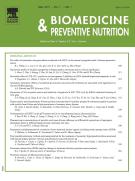Diallyl sulfide attenuates renal injury by altering the expressions of COX-2 and NF-?B during cisplatin-induced nephrotoxicity in male wistar rats - 30/05/14
 : Assistant Professor, Prakash Dharmalingam a
: Assistant Professor, Prakash Dharmalingam aAbstract |
Cis-diamminedichloroplatinum (II) (cisplatin) is an effective chemotherapeutic agent successfully used in the treatment of a wide range of tumours. However, its full clinical utility is limited due to some adverse effects. Diallyl sulfide (DAS) is a major flavour component of garlic. The present study is to evaluate nephroprotective effect of DAS on the cisplatin-induced nephrotoxicity. Male Wistar rats were divided into four groups of six each: Group I served as control rats; Group II received single intraperitoneal (i.p) injection of 7mg/kg BW cisplatin. Group III received both cisplatin and DAS (100mg/kg BW intraperitoneally); Group IV received DAS alone. Cisplatin administration significantly alters the levels of serum marker enzymes and renal tissue markers. DAS administration significantly reduced levels of serum marker enzymes and improved renal functions. Increase MDA level with a concomitant reduction in enzymic antioxidants and non-enzymic antioxidants were observed in cisplatin-induced group, which was reversed upon DAS treatment. Cisplatin-induced nephrotoxicity which is also supported by histopathological studies and elevated expressions of nuclear transcription factor-kappa B and Cyclooxygenase-2 in cisplatin-induced group, and it were attenuated upon DAS treatment. These results indicate that the antioxidant effect of DAS might contribute against cisplatin-induced nephrotoxicity in rats.
Le texte complet de cet article est disponible en PDF.Keywords : Cisplatin, NF-κB, COX-2, Diallyl sulphide, Antioxidants, Garlic
Plan
Vol 4 - N° 2
P. 291-297 - avril 2014 Retour au numéroBienvenue sur EM-consulte, la référence des professionnels de santé.
L’accès au texte intégral de cet article nécessite un abonnement.
Déjà abonné à cette revue ?

